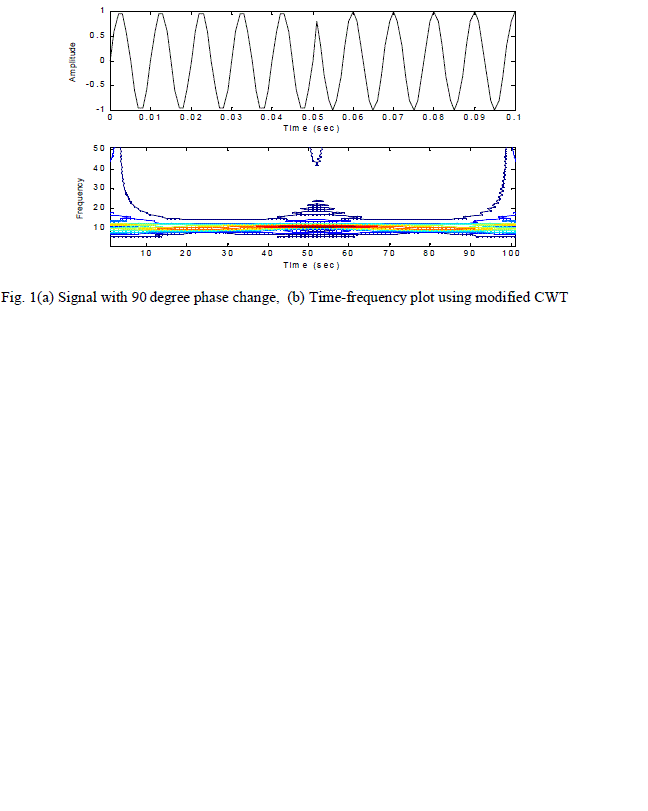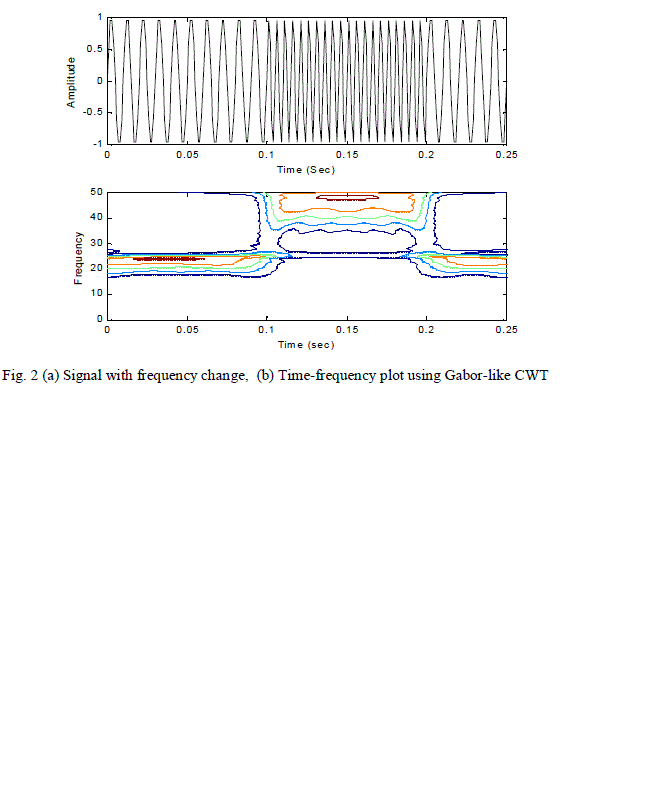Keywords
|
| Orthonormal bases , Wavelets , Multiresolution Approximation , Phase change , Spline window , Non- Stationary , Gaussian function |
INTRODUCTION
|
| Signal processing has played an important role in different engineering applications. Early developments have treated image processing as more of arts than science, but with the time, recent algorithms for different vision systems require strong mathematical support for the better performance of such systems for a variety of images. Eminent signal processing researchers have claimed that a signal contains information at different scales. The notion of “Scale” is being used by signal processors while the notion of “Resolution” is frequently associated with the image processing literature. A signal or an image can be decomposed into different scales in the spatial domain. This time-scale or spacescale representation of a signal is commonly known as multiresolution signal analysis. Wavelet transform [1] has played an important role in signal processing for detection of local details from a non-stationary signal. However, detection of a change in the absolute phase of a constituent frequency of a ‘non-stationary’ signal is not possible by using the Windowed (or short-time) Fourier Transform (WFT) and the Continuous Wavelet Transform (CWT) [2]. This has developed a modified CWT to supplement both WFT and CWT, which are treated as two fundamental tools in signal processing. A new transform for detection of phase change. In this case, the analysis functions are obtained by dilation of a spline window which is frequency dependent. This property enables the present transform to “zoom in” on singularities and makes it very attractive for the analysis of non-stationary signals. Another advantage of this technique is that spline functions are more localized than the Gaussian function which is used in WFT. It is well known from the wavelet literature that WFT and CWT can be used for time-frequency localization of non-stationary signals[3]. But they do not provide us phase information of a signal. On the other hand, the proposed modified CWT will provide phase information efficiently. This shows a distinct improvement over the WFT and CWT. From Fig.1 it is seen that the phase information is localized. This reveals the suitability and effectiveness of the proposed transform for analysis of non-stationary signals. The proposed transform may be useful for different signal processing applications [5]. |
II. THE WAVELET TRANSFORM
|
| Wavelet transforms are useful to extract local details from “non-stationary” signals [1]. There are two different types of wavelet transforms – |
| (A) The continuous wavelet transform and |
| (B) The discrete wavelet transform. |
A .The Continuous Wavelet Transform
|
| The continuous wavelet transform (CWT) provide us a similar type of time-frequency description discussed in the preceding section with few very important differences . The CWT is defined as : |
 |
| The functions a,b ïÃÂù are called wavelets. Note that the function ïÃÂù is called as the mother wavelet. |
| In the case of CWT two index are used : |
 It is noteworthy to mention here that both ïÃÂù and ‘g’ are real. It is noteworthy to mention here that both ïÃÂù and ‘g’ are real. |
B .The Discrete Wavelet Transform
|
| The discrete wavelet transform (DWT) can be derived from Eq. (1.15) (defined for CWT) by restricting ‘a’ and ‘b’ to have only discrete values : |
 |
| Proper choice of a 0 , b 0 and ïÃÂù a,b constitute an orthonormal basis set for different signal and image processing applications |
III. THE MODIFIED WFT & CWT
|
| Let g(k) represent a discrete signal and let w(k) denote a window sequence. Then the WFT of g(k) is defined as : |
 |
| where and n=0,1,…., N-1. Note that |
| represent the discrete Fourier transform of the particular portion of the signal . |
| The CWT of g(k) is defines as : |
 |
| where b is a scale parameter and ïÃÂù is a Gabor-wavelet obtained through modulation of a window function w(x) given as |
 (2) (2) |
| Note that w(x) is the Gaussian function given by |
 (3) (3) |
| The Gaussian window by a symmetrical B-spline window. It may be noted that B-spline windows provide a compact support and closely approximates a Gaussian window [9]. A centred B-spline function of degree n can be generated by evaluating (n+1)-fold convolution of a unit rectangular pulse. The corresponding discrete B-spline window with an additional resolution factor ‘m’ can be obtained by enlarging the spline function of degree n, i.e, ïÃÂân(x) by an integral factor m and sampling at the integers. |
 (4) (4) |
| Note that ‘m’ is the resolution factor. The resulting complex B-spline wavelet can be explicitly written as : |
 (5) (5) |
| This is not surprising to claim that the time-frequency localization of this function is improved rapidly with the degree as it converges to a Gaussian function. The resolution factor m to be an inverse function of the frequency of the signal being localized. Thus, |
 (6) (6) |
| Since the effective width of the B-spline window is a function of the frequency f, the phase information can be extracted (with full information about the complex phase at each frequency component). This shows a definite improvement over the existing CWT & WFT techniques. The amplitude and phase spectra are given by |
 (7) (7) |
| Note that WïÃÂù is the new modified CWT. |
.IV. RESULTS AND DISCUSSIONS
|
| Both time and frequency resolutions are fixed in the case of Windowed Fourier Transform (WFT) and short-time Fourier transform (STFT). Hence, the WFT or STFT approach is particularly suitable for the analysis of signals with slowly varying periodic or stationary characteristics. The wavelet transform provide us a time-scale analysis [1] and they have shown high performance to detect local details from non-stationary signals (or transient signals). However, they do not provide us a precise scale-frequency analysis for transient signals. Center frequencies of band-pass filters connected with wavelets are fixed and depend upon the scale parameter. Hence, wavelet analysis is not very attractive for harmonic analysis of distorted signals. The discrete transform introduced in this Section may be treated as the projection of the time-series {g(k)} onto a space consisting of orthonormal basis vectors. The time-frequency localization of a signal can be achieved by using the proposed transform efficiently. The proposed transform can be evaluated by using the following algorithm: |
Algorithm :
|
| Step 1 :Find the Fourier transform of the B-spline window using Eq.(5). |
| Step 2 :Find the Fourier transform of the given discrete-time signal {g(k)} (with N number of data points & unit sampling) by using FFT. |
| Step 3 :Shift the B-spline window spectrum with index l & multiply with the Fourier transform of the given discretetime signal. |
| Step 4 :Find the inverse Fourier transform of the product to produce the row of the transform matrix WïÃÂù corresponding to a constituent frequency ‘n’. |
| Step 5 : Repeat steps 3 & 4 till one gets all rows of WïÃÂù matrix. |
| The proposed algorithm has been used to find the new transform matrix WïÃÂù for different signals. Two different signals to highlight the power and usefulness of the proposed transform. A sinusoidal signal with a phase change at time t=0.05 sec has been shown in Figure 1 (a) and its Time-frequency plot has been shown in Figure 1(b). From figure1 , it is seen that the phase change in the original signal is detected accurately. Figure 2(a) represents a signal with change in frequency of the signal from 100 Hz to 200 Hz during time interval 0.1 to 0.2 sec. The time-frequency plot of the frequency changing signal has been shown in Fig 2(b), which clearly shows the superiority of the proposed method for detection of frequency change as well. |
V. CONCLUSION
|
| This paper deals with a modified Gabor-like Windowed Continuous Wavelet Transform (CWT) for localization of phase spectrum. This proposed transform provide a frequency-dependent resolution while maintaining a relationship with the Windowed Fourier Transform (WFT) and Continuous Wavelet Transform (CWT), hence useful for multiresolution signal analysis. Here a localized scalable B-spline window has been used for dilation and translation while keeping modulating sinusoids fixed along the time axis. It is interesting enough to note here that the distinctive frequency-dependent resolution features are absent in both WFT and CWT. |
Figures at a glance
|
 |
 |
| Figure 1 |
Figure 2 |
|
| |
References
|
- S. M. Metev and V. P. Veiko, Laser Assisted Microtechnology, 2nd ed., R. M. Osgood, Jr., Ed. Berlin, Germany: Springer-Verlag, 1998.
- J. Breckling, Ed., The Analysis of Directional Time Series: Applications to Wind Speed and Direction, ser. Lecture Notes in Statistics. Berlin,Germany: Springer, 1989, vol. 61.
- S. Zhang, C. Zhu, J. K. O. Sin, and P. K. T. Mok, “A novel ultrathin elevated channel low-temperature poly-Si TFT,” IEEE Electron DeviceLett., vol. 20, pp. 569–571, Nov. 1999.
- M. Wegmuller, J. P. von der Weid, P. Oberson, and N. Gisin, “High resolution fiber distributed measurements with coherent OFDR,” in Proc.ECOC’00, 2000, paper 11.3.4, p. 109.
- R. E. Sorace, V. S. Reinhardt, and S. A. Vaughn, “High-speed digital-to-RF converter,” U.S. Patent 5 668 842, Sept. 16, 1997.
- (2002) The IEEE website. Online]. Available: http://www.ieee.org/
- M. Shell. (2002) IEEEtran homepage on CTAN. Online]. Available: http://www.ctan.org/texarchive/macros/latex/contrib/supported/IEEEtran/
- FLEXChip Signal Processor (MC68175/D), Motorola, 1996.
- “PDCA12-70 data sheet,” Opto Speed SA, Mezzovico, Switzerland.
- Karnik, “Performance of TCP congestion control with rate feedback: TCP/ABR and rate adaptive TCP/IP,” M. Eng. thesis, Indian Instituteof Science, Bangalore, India, Jan. 1999.
- J. Padhye, V. Firoiu, and D. Towsley, “A stochastic model of TCP Reno congestion avoidance and control,” Univ. of Massachusetts, Amherst,MA, CMPSCI Tech. Rep. 99-02, 1999.
- Wireless LAN Medium Access Control (MAC) and Physical Layer (PHY) Specification, IEEE Std. 802.11, 1997.
|